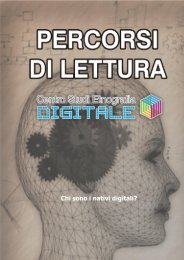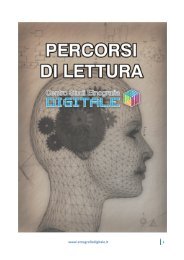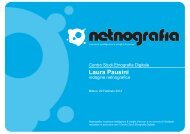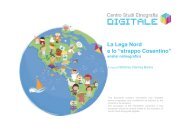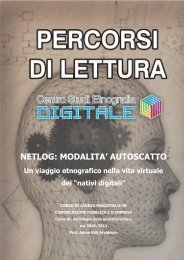Netnography: The Marketer's Secret Weapon - NetBase.com
Netnography: The Marketer's Secret Weapon - NetBase.com
Netnography: The Marketer's Secret Weapon - NetBase.com
Create successful ePaper yourself
Turn your PDF publications into a flip-book with our unique Google optimized e-Paper software.
<strong>Netnography</strong>: <strong>The</strong> Marketer’s<br />
<strong>Secret</strong> <strong>Weapon</strong><br />
How Social Media Understanding Drives Innovation<br />
By Robert V. Kozinets, BBA, MBA. Ph.D.<br />
MARCH 201 0
Executive Summary<br />
Marketers in today’s <strong>com</strong>petitive world need an edge. This paper offers two of them. First, it tells marketers to<br />
consider social media not just as a marketing tool, but as a way to continuously build high-level consumer insight.<br />
Second, it offers a rigorous method based in anthropology for building social media data into applied cultural<br />
insights. That method is called netnography.<br />
In netnography, online interactions are valued as a cultural reflection that yields deep human understanding. Like<br />
in person ethnography, netnography is naturalistic, immersive, descriptive, multi-method, adaptable, and focused<br />
on context. Used to inform consumer insight, netnography is less intrusive than ethnography or focus groups,<br />
and more naturalistic than surveys, quantitative models, and focus groups. <strong>Netnography</strong> fits well in the front-end<br />
stages of innovation, and in the discovery phases of marketing and brand management.<br />
<strong>Netnography</strong> follows six overlapping steps:<br />
1. Research planning<br />
2. Entrée<br />
3. Data collection<br />
4. Interpretation<br />
5. Ensuring ethical standards<br />
6. Research representation<br />
A short illustration of a <strong>com</strong>putationally assisted netnographic approach to a brand study of Listerine is<br />
provided. It demonstrates how insights can be used to inform marketing activities including brand perceptions,<br />
brand positioning and repositioning, segmentation studies, new product development and innovation, trend<br />
identification, new service models for co-creation of value, social media usage and opportunities for marketing<br />
campaign activation. By leveraging the power of netnography, marketers can make better business decisions,<br />
giving <strong>com</strong>panies a unique <strong>com</strong>petitive advantage.<br />
<strong>Netnography</strong>: <strong>The</strong> Marketer’s <strong>Secret</strong> <strong>Weapon</strong> How Social Media Understanding Drives Innovation 1
Marketing and Social Media Space<br />
<strong>The</strong> new social world is online. Internet penetration rates continue their global climb. Reasonably, we can say that<br />
over a billion people now participate in various forms of social media. We are in the midst of a technology-led<br />
<strong>com</strong>munal revolution.<br />
<strong>The</strong> implications for marketers, marketing researchers, and managers of all stripes are vast. Consumers are<br />
sharing all sorts of emotions and information with each other about an incredible panoply of products, retailers,<br />
and brands.<br />
<strong>The</strong> online environment offers us nearly unlimited access to consumer-to-consumer <strong>com</strong>munications that are:<br />
• relevant and detailed<br />
• from a naturally-occurring context<br />
• unelicited<br />
• obtained in an unobtrusive way, and<br />
• obtainable in a timely, effective, and efficient manner<br />
This data is raw. It is authentic. Spontaneous. Indigenous. Unforced. Unadorned. Powerful. Highly involved and<br />
often spectacularly creative.<br />
Marketers have responded by beginning to build social media into their marketing plans, their advertising and<br />
promotional campaigns. But in terms of consumer insight, marketing is dominated by the same old methods.<br />
Focus groups. Surveys. Data models. <strong>The</strong> move to build rich understanding with the cornucopia of online<br />
consumer data is just beginning.<br />
What is in this overflowing horn of plenty? A range of overlapping opportunities. Applied to business and<br />
marketing needs, netnography builds deep consumer insights that provide:<br />
• All-embracing descriptions of the marketplace—segments, product groupings, attribute sets<br />
• Realistic <strong>com</strong>prehension of online <strong>com</strong>munication—categories, trends, symbols, images<br />
• Social understandings of consumer choice—influencers, adopters, WOM properties<br />
• Natural views of brand meaning—decoding authentic consumer language and terms, as well as visual<br />
and audiovisual analysis<br />
• Embedded discoveries of consumer innovation—based in lead user, inno-tribe, and prosumer creativity<br />
Compare netnography to the focus group or survey data dominating the world of consumer insight research.<br />
• Focus groups offer detailed and relevant data. But they are elicited, obtrusive and <strong>com</strong>pletely artificial.<br />
<strong>The</strong> one-time group dynamics are synthetic and strange.<br />
• Surveys are artificial, obtrusive, and elicited. We often have no way of knowing if our survey questions<br />
are relevant to the consumers’ world.<br />
• Both focus groups and surveys can be expensive. Consider that a national set of focus groups can easily<br />
run in the hundreds of thousands.<br />
<strong>Netnography</strong>: <strong>The</strong> Marketer’s <strong>Secret</strong> <strong>Weapon</strong> How Social Media Understanding Drives Innovation 2
<strong>The</strong>re are currently only a handful of far-sighted <strong>com</strong>panies that conduct netnography. Although it is now globally<br />
established in the academic world of consumer and marketing research, the very notion of online ethnography<br />
is still unknown to most marketers, product managers, marketing researchers, and product innovation and<br />
consumer insight specialists.<br />
That is why you need to read this paper.<br />
You need to read it because netnography offers a sharp new arrow in the consumer research quiver, a powerful<br />
new tool for the marketing workbench. Or, if you prefer Sun Tzu’s “<strong>The</strong> Art of War”…<br />
<strong>Netnography</strong> is the marketer’s secret weapon for developing innovative ideas.<br />
Introducing <strong>Netnography</strong><br />
In August of 1995, there were 18,000 websites on the net.<br />
At the time, I was a Ph.D. student studying how culturally embedded consumer innovation occurs in person, and<br />
on the Internet, in fan cultures.<br />
Beginning my research career with this amazing new tool (or was “cyberspace” just a “fad”?), I became convinced<br />
that online <strong>com</strong>munities had momentous implications for marketing. I believed that the Internet’s ability to<br />
connect consumer to one another would change the marketing world forever.<br />
In 1995, on that group of a few thousand websites and many active usenet newsgroups, I began developing a new<br />
method for Internet-based marketing research: netnography.<br />
<strong>Netnography</strong> reflects an unusual hybrid of training: I am an anthropologist, trained in marketing. I apply<br />
anthropology and its time-tested method of ethnography to an expansive range of questions about markets and<br />
consumers. To simplify things considerably, let us say ethnography is built upon several foundations:<br />
1. It is natural. It seeks out and approaches a culture where it exists, living and breathing.<br />
2. It is immersive. It seeks cultural understanding from an active stance that develops engaged personal<br />
participation alongside “objective” observation.<br />
3. It is descriptive. It seeks “rich description,” the thick, evocative, living language that conveys the subjective<br />
reality and emotional truth of culture members.<br />
4. It is multi-method. It promiscuously uses other methods such as interviews, semiotics, projectives,<br />
photography, and video to <strong>com</strong>plete the portrayal of the lived reality of the culture.<br />
5. It is adaptable. Ethnographies have been conducted with every major culture on Earth. As Sigourney<br />
Weaver demonstrated not only in “Gorillas in the Mist,” but also in “Avatar,” ethnography even works<br />
on nonhumans.<br />
<strong>Netnography</strong> is Internet, or technologically networked, ethnography. <strong>Netnography</strong> is ethnography adapted to the<br />
<strong>com</strong>plexities of our contemporary, technologically mediated social world.<br />
<strong>Netnography</strong>: <strong>The</strong> Marketer’s <strong>Secret</strong> <strong>Weapon</strong> How Social Media Understanding Drives Innovation 3
<strong>Netnography</strong> is ethnography that bridges the century-old method of Bronislaw Malinowski and Franz Boas with<br />
the reality that many teens conduct more of their social life on Facebook than in the schoolyard, that new moms<br />
get much of their information not from their family or friends, but from new mom web forums, and that, in many<br />
workplaces, bloggers and tweeters are the most important sources of industry news and opinions.<br />
Because many of us live our lives in an interrelated matrix of online and offline social behaviors, meaningful<br />
studies of culture must attend to both types of <strong>com</strong>munication. <strong>Netnography</strong> adapts ethnography to this<br />
<strong>com</strong>plex <strong>com</strong>bination of online and offline sociality by giving us ways to study life in the time of technologicallymediated<br />
culture.<br />
How is <strong>Netnography</strong> Different?<br />
<strong>The</strong>re are many different ways to study consumers’ interactions in the online social world. Here are a few of the<br />
major ones:<br />
• We can survey people and ask them about their behaviors<br />
• We can track and trace online behaviors and clickstreams<br />
• We can set up online focus groups, panels, and artificial <strong>com</strong>munities<br />
• We can code, catalog and categorize data.<br />
<strong>The</strong> key to netnography, and what makes it different from methods like focus groups, surveys, CRM data models,<br />
clickstream tracking, and even artificial <strong>com</strong>munities, is this:<br />
<strong>Netnography</strong> is focused on cultural insights.<br />
<strong>Netnography</strong> is different because it treats online <strong>com</strong>munications not as mere “content,” but as social interaction,<br />
as embedded expression of meaning, and as cultural artifact.<br />
<strong>Netnography</strong> pays very close attention to context.<br />
<strong>Netnography</strong> looks not merely at the words present in social interactions, but at the forum elements, the<br />
<strong>com</strong>municator characteristics, the language, the history, the meaning, the type of interaction. It examines fonts,<br />
spacing, symbols, texts, images, photos, and videos.<br />
And, like its predecessor ethnography:<br />
1. It is naturalistic, following social expression to its online appearances.<br />
2. It is immersive, drawing the researcher into an engaged, deeper understanding.<br />
3. It is descriptive, seeking to convey the rich reality of contemporary consumers’ lives, with all of their hidden<br />
cultural meanings as well as their colorful graphics, drawings, symbols, sounds, photos, and videos.<br />
4. It is multi-method, <strong>com</strong>bining well with other methods, both online and off, such as interviews and<br />
videography. Like all methods, netnography often works even better when triangulated with other<br />
sources of insight. For example, <strong>com</strong>plement netnography with targeted surveys to validate the<br />
replicability of findings.<br />
5. It is adaptable, moving effortlessly from newsgroups to blogs, wikis, virtual worlds, social networking sites,<br />
podcasting and mobile online/offline <strong>com</strong>munities, and whatever else the future has in store.<br />
<strong>Netnography</strong>: <strong>The</strong> Marketer’s <strong>Secret</strong> <strong>Weapon</strong> How Social Media Understanding Drives Innovation 4
More than this, netnography offers specific, rigorous guidelines about:<br />
• How to plan research and plan for work in the field. An organized netnographer will need a research<br />
question, or set of questions, to direct her investigation.<br />
• How to conduct netnographic entrée. How to use a focused research question to hone in, reach out, find,<br />
enter, and investigate the different online fields where a culture or <strong>com</strong>munity expresses and gathers.<br />
• How, when, and where to collect data about the culture and <strong>com</strong>munity.<br />
• How to apply consistent, interactively-adjusted, insightful analysis and interpretation to the data.<br />
• How to apply strict ethical research standards and procedures.<br />
• How to evaluate and present the end-product of the research.<br />
Stated in brief terms, netnography follows these six overlapping steps: research planning, entrée, data collection,<br />
interpretation, ensuring ethical standards, and research representation. Each of these topics merits a longer<br />
discussion of its own.<br />
Because online data collection can be so challenging and interesting, let us proceed to a brief examination<br />
of this topic.<br />
Online Data Collection and Computationally Assisted <strong>Netnography</strong><br />
Two of the chief data collection challenges for the netnographer are: (1) how to find the appropriate data,<br />
and (2) how to balance vast amounts of available data with the ethnographic necessity of an in-depth<br />
cultural understanding.<br />
As anyone who has used a search engine to investigate a topic knows, Internet data is easy and cheap. Type the<br />
brand name “Listerine” into the main Google search engine and you will be faced with approximately 907,000 hits.<br />
It is relatively easy for someone to download a few dozen of these web pages and forum posts about the brand,<br />
review and summarize them, and then to pass themselves off as an online anthropologist. However, something<br />
would be missing.<br />
<strong>The</strong>re are likely to be at least two major problems with the 907,000 or so hits about the Listerine brand, or<br />
any other popular brand, product, or market category that we might be interested in investigating. First,<br />
there are many different <strong>com</strong>munications going on at once, and this makes finding the research appropriate<br />
<strong>com</strong>munications difficult. <strong>The</strong>re is advertising, official <strong>com</strong>munications, spam, promotions, and reposts coexisting<br />
with the social, consumer-to-consumer interactions that drive netnography. Google only gives us the first 1,000<br />
hits. And even with those thousand hits, we face a situation of abundance. More is not always better. Even if we<br />
were to transcend the <strong>com</strong>mon search engine’s limitation, the prospect of manually downloading and reading<br />
tens of thousands of online interactions is a daunting time <strong>com</strong>mitment.<br />
<strong>Netnography</strong> requires the researcher to investigate the range of pertinent cultural activity occurring in online<br />
social spaces. <strong>The</strong>se social spaces have been growing prodigious both in volume and in variety. Because of these<br />
two facts, I have found it increasingly valuable to have quality software tools as an adjunct to netnography.<br />
<strong>Netnography</strong>: <strong>The</strong> Marketer’s <strong>Secret</strong> <strong>Weapon</strong> How Social Media Understanding Drives Innovation 5
I have even recently coined a term for this useful mode of netnography: <strong>com</strong>putationally assisted netnography.<br />
Computationally assisted netnography adds the careful use of software tools to the protocols of the netnographic<br />
process in order to assist the researcher. Wisely deployed, high-quality software-based <strong>com</strong>putational tools can<br />
help the netnographer by assisting with the following tasks:<br />
1. Sourcing: allows the netnographer to scan the online environment for relevant and interaction-oriented<br />
mentions of brands, categories, product usage situations, and markets. Good tools will allow for a breadth<br />
and variety of sites. <strong>The</strong> more the better.<br />
2. Tracking: provides some context to the data so that relevance and cultural insight can be judged. <strong>The</strong>y will<br />
also provide source information (preferably hyperlinked), so that the data can be usefully traced to its source<br />
3. Marking: allows the researcher to write and save their own notes and observations on top of the data set<br />
4. Collecting: facilitates the archiving and collection of sets of data in ways that organize it without losing<br />
the subtlety of its cultural condition<br />
5. Reducing: at some point, large amounts of the data need to be reduced into order to build them into<br />
coherent insights. Strong tools will be flexible, subtle, and adaptable<br />
6. Visualizing: using different types of analysis, unexpected insights can occur when data is presented in a<br />
new visual ways<br />
7. Pervading: with easy, user-friendly interfaces, <strong>com</strong>putation tools can allow the researcher to be on top of<br />
the dynamic, ever-unfolding, naturally-occurring situation that is online interaction. Real-time consumer<br />
insights inform better and better strategic decisions.<br />
As this paper suggests, <strong>com</strong>putational software tools can be most helpful in the selection, data collection, and<br />
data analysis stages of the netnographic research process.<br />
<strong>The</strong> Power of <strong>Netnography</strong>: Taking a Strong Swig of Social Media<br />
Participant observation and keen description are at the heart of my netnographies. I also use many types of tools<br />
to conduct them. I use search engines such as Google, including Google Groups, Google Trends, and Google<br />
Social Search. I also use Technorati, and Twitter Search. I use qualitative data analysis software such as Atlas.<br />
ti. and NVivo. For automatic semantic recognition, organization of relevant semantic forms and patterns, and<br />
location of online conversation sites, and overall understanding of what consumers are saying, I have recently<br />
been using <strong>NetBase</strong>’s ConsumerBase tool. I continue to build my cultural insights with non-textual searches of<br />
sites like Flickr, YouTube, and DeviantArt.<br />
Let us take a very short, simple example. Consider the power of an integrated, <strong>com</strong>putationally aided<br />
netnography to enlighten a brand manager about brand meanings and consumer innovation.<br />
<strong>The</strong> example I chose is Johnson and Johnson’s Listerine brand. Participating mainly offline in Listerine use and<br />
introspection, and online reading, viewing and collection, I used a selection of search engines such as Google,<br />
Technorati, and Twitter Search, as well as scans of visual and audiovisual data on Facebook, YouTube, Flickr, and<br />
DeviantArt. I used Netbase’s ConsumerBase tool to locate, organize, and classify these findings, and to recognize<br />
semantic patterns among them for my further investigation.<br />
<strong>NetBase</strong> technology, which also includes a powerful lens for online social behavior, revealed a range of oral<br />
health blogs, medical and medicinal advice forums, social media groups and microblog feeds that mention and<br />
discuss Listerine.<br />
<strong>Netnography</strong>: <strong>The</strong> Marketer’s <strong>Secret</strong> <strong>Weapon</strong> How Social Media Understanding Drives Innovation 6
In the netnography, I discovered that Listerine has be<strong>com</strong>e thoroughly absorbed into popular culture’s social<br />
conversations. Currently, mentions of the product include this insulting gem from celebrity gossip site perezhilton.<br />
<strong>com</strong>: “If Jon Gosselin is really strapped for cash, we suppose he could always pose nude, but then we would have<br />
to find a way to soak our brains in Listerine.” Multiple sites also mentioned Listerine in connection with mentions<br />
of John Mayer’s kiss-and-tell lovelife. In each of these mentions, Listerine’s cachet drew from its harsh overtones,<br />
its connotation as a strong, necessary medicine that purifies, but that has an edge of nasty-tasting chemical<br />
cruelty about it.<br />
This netnography begins with the question “Which online <strong>com</strong>munities and other social spaces do consumers<br />
who are interested in Listerine congregate to?” <strong>The</strong> next set of questions might concern more specific purposes,<br />
such as “What brand meanings do culture members associate with Listerine” and “What are some of the novel<br />
uses to which Listerine is put?”<br />
We find a range of Listerine-based opinions in domestic blogs such as Lost in Laundry, <strong>The</strong> Daily Bitch, and <strong>The</strong><br />
Happy Slob’s Guide to Housekeeping. In these blogs, we often find that the use and, especially, scent of Listerine<br />
are nostalgically and practically linked to the notion of “grandpa.” Grandpa always made me gargle with Listerine<br />
when I had a little cough or cold. Grandpa soaked his feet in Listerine. Coming up close for a hug, my Grandpa would<br />
always have the slight lingering scent of Listerine about him. <strong>The</strong> mom blogger at “From Cribs to Carkeys” wrote:<br />
“Generally, the idea of Listerine gives me the shivers. I think of the old school original flavor that my grandpa used<br />
to use and want to run screaming.”<br />
In a primordial sense explained well by cultural analyst Clotaire Rapaille, consumers encode these memories<br />
and impressions as deeply significant. Symbolically, the brand is scent-focused, medicinal, old, stale, and male.<br />
It arouses stories of the past, of family, of childhood. This is a brand that is rooted in nostalgia, in hard-to-budge<br />
meanings of the foul smelling yellow mouthwash (at least to the mom blogger target). To a brand manager<br />
interested in brand meanings and extensions, however, they speak volumes about limitations and opportunities<br />
(such as new geriatric lines and targeted products).<br />
<strong>The</strong>se meanings of chemical harshness and artificiality are echoed in visual imagery that portrays Listerine bottles<br />
with strong muscular arms, as a hand grenade, and with an alien blue glow. In addition, far-reaching old Listerine<br />
advertising lives on, repeated and reprised, showing Listerine being used as an aftershave, as a skin ointment to<br />
treat wounds, as a cold remedy, and as nose drops.<br />
In fact, in 2008, Listerine was called to task for shameless false advertising by blog Mental_Floss, which rated<br />
Listerine #1 on its all time list of offenders. <strong>The</strong> blog overviewed some of the brand’s far-fetched health claims<br />
over the years, including using the product on stings, as a dandruff preventative, as a substitute for flossing, and<br />
preventing “halitosis”, the bad breath “disease” invented by Listerine’s ad agency.<br />
It is fascinating to note how many of these uses, propagated almost a century ago many of them disputed by the<br />
FTC and denied in the 1970s by “corrective advertising,” live on in the Internet sphere of today. As if the old liquid<br />
maintained some of the slippery snake oil magic of its early years, consumers continue to re<strong>com</strong>mend Listerine<br />
for a mélange of different ailments and usages.<br />
<strong>Netnography</strong>: <strong>The</strong> Marketer’s <strong>Secret</strong> <strong>Weapon</strong> How Social Media Understanding Drives Innovation 7
<strong>The</strong>se creative uses appear in a variety of different forums. We still see Listerine re<strong>com</strong>mended to prevent or treat<br />
dandruff, to treat cuts and bruises, and for use as a bracing (if foul-smelling) aftershave. Metafilter and various<br />
other forums re<strong>com</strong>mend treating canker sores with Listerine. Soaking your toes in Listerine, we are told, will kill<br />
toenail fungus.<br />
In the recipe-sharing <strong>com</strong>munity RecipeZaar, we see Listerine re<strong>com</strong>mended as a “recipe” against mosquitoes. It<br />
also appears in other recipes, such as one that <strong>com</strong>bines equal parts Listerine with baby oil and warm water to<br />
treat dogs’ dry itchy skin and “hot spots.”<br />
In Scott Products’ Common Sense <strong>com</strong>munity, a forum where “thousands of members across the country and<br />
exchange real-life Common Sense wisdom for saving time and money” we can find innovative consumer posts<br />
about Listerine, suggesting it be used:<br />
• On a sponge, to kill ants or bugs anywhere in your home and keep them away<br />
• To take the stains off of your bathroom counter<br />
Another popular use is as a toilet cleaner. And there are many more medicinal and around-the-house uses for<br />
Listerine. Some representative examples follow:<br />
• On the early-retirement.org forum, we find a concoction of Listerine, Epsom salt, and beer re<strong>com</strong>mended<br />
for use as a mosquito repellent.<br />
• <strong>The</strong> alternative health site Ayurvediccure.<strong>com</strong> re<strong>com</strong>mends applying Listerine to a sterile cotton pad and<br />
applying it twice a day to cure yeast infections.<br />
• Myhomeremedies.<strong>com</strong> re<strong>com</strong>mends “dousing” the hair with Listerine in order to kill head lice.<br />
• Wonderhowto.<strong>com</strong> provides a video in which a grey-bearded pharmacologist wearing a tie tells us how to<br />
cure athlete’s foot using a <strong>com</strong>bination of vinegar and Listerine.<br />
• Various gardening blogs and home care sites re<strong>com</strong>mend spraying flowers, such as roses, with different<br />
types of Listerine-based solutions (including some that mix Listerine with water and tobacco)<br />
<strong>The</strong> cultural themes circulating around these uses are those of strength in killing and repelling. Listerine kills not<br />
only bacteria, but fungus. It also kills small insects such as aphids, ants, and lice. It also repels them, and other<br />
pesky insects, like mosquitoes.<br />
Online, we can see how the creative uses of Listerine move it closer and closer to that of a pesticide. Even if<br />
Listerine worked as an insecticide and a repellent, an insightful cultural analyst would immediately recognize that<br />
the toxic brand associations of pesticide-in-your-mouth would be undesirable.<br />
So, from this brief netnography, we learn about some key issues and opportunities for the Listerine brand. <strong>The</strong> brand is:<br />
• Culturally meaningful and omnipresent<br />
• Associated with harsh, strong, purification<br />
• Linked to age and the past<br />
• Associated with grandpa<br />
• Seen as artificial and chemical<br />
• Associated with many different uses (i.e., fun to experiment with)<br />
• Linked to home cleaning products<br />
• Viewed as a natural home remedy<br />
• Re<strong>com</strong>mended for garden use<br />
• Linked to pesticides<br />
<strong>Netnography</strong>: <strong>The</strong> Marketer’s <strong>Secret</strong> <strong>Weapon</strong> How Social Media Understanding Drives Innovation 8
Listerine’s brand managers can use this necessarily brief netnographic analysis to focus their efforts. Should the<br />
brand be repositioned from the past to the present and future? How might this happen? Is there strong value in<br />
the nostalgia appeal? Can the “shameless” trickery advertising of Listerine’s past be used to current advantage?<br />
Can some of its creative consumer uses be<strong>com</strong>e useful brand extensions (Listerine Garden Helper? Listerine<br />
Natural Skin Care?)? How can the toxic, pesticidal cultural meanings of the brand be managed? How can some of<br />
these sites of social media activity be<strong>com</strong>e sites for Listerine’s marketing campaign activation?<br />
Although, in a full-length netnography, these ideas would be developed in significant breadth and depth, this<br />
example suffices to underscore how social media data, <strong>com</strong>bined with netnographic analysis attuned to cultural<br />
insights, can yield potentially valuable ideas about consumer impressions, brand meanings, brand extensions, new<br />
product innovations, and social media sites of marketing activation.<br />
<strong>Netnography</strong> and Management<br />
A thorough, detailed, netnographic study can reveal much about consumer behaviors, opinions, tastes,<br />
impressions, and interactions. Like face-to-face ethnography, netnography provides a window into the realities of<br />
consumer groups as they go about their lives.<br />
We learn about the local language, the history, the players, the practices and rituals, as well as the enculturation<br />
and education of cultural members. More than this, we learn where consumers congregate, what they share, and<br />
how they <strong>com</strong>municate. We gain deep insights into who our consumers are, where and how they find sources of<br />
<strong>com</strong>munity, who are the most influential voices in those consumer <strong>com</strong>munities, what are the meanings, rituals,<br />
and traditions of these <strong>com</strong>munities, and so on. With analysis and interpretation, we discover the variety of forms<br />
and the patterns within how and why they consume.<br />
Over the last ten years, I have had the privilege of working with a range of far-sighted global <strong>com</strong>panies,<br />
exploring the applied use of netnography. Working with clients such as American Express, Campbell’s Soup, eBay,<br />
and Merck, we have found that the intelligence of netnography empowers a range of important marketing and<br />
business decisions.<br />
In particular, we have found that netnography is a powerful way to understand the changing marketplace, to gain<br />
an understanding of tomorrow’s trends today, and to gain ideas and insights as valuable inputs to the front-end<br />
ideation process. Today, netnography enlightens managers on matters such as:<br />
• Advertising reception, alteration and interpretation<br />
• Brand <strong>com</strong>munity opportunities and negotiations<br />
• Brand perception<br />
• Brand positioning and repositioning opportunities<br />
• Choice making<br />
• Community management<br />
• Competitive analysis<br />
• Innovation in new products and services<br />
• New service models for co-creation of value<br />
• Product and category usage<br />
• Segmentation forms and patterns<br />
• Social media audits, usage, and opportunities<br />
• Trend identification<br />
• Web-page and interface design<br />
<strong>Netnography</strong>: <strong>The</strong> Marketer’s <strong>Secret</strong> <strong>Weapon</strong> How Social Media Understanding Drives Innovation 9
<strong>Netnography</strong> offers transformative new opportunities to today’s marketing researchers and marketers. However,<br />
change is not easy. Many <strong>com</strong>panies have their marketing research systems oriented around the input from<br />
regular focus groups and surveys.<br />
To begin making a transition to a world of richer, more realistic, more natural, and more informative consumer<br />
data, here is an 8-step plan to guide you.<br />
1. Understand and state your consumer insight goals—How do they currently involve the benefits of social<br />
media and netnography? How might they involve it in the future?<br />
2. Educate yourself about the different methods for using naturalistic social media data. Remember that<br />
being an early adopter of effective new methods can carry <strong>com</strong>petitive advantages both for your career<br />
and your <strong>com</strong>pany.<br />
3. Educate and train your co-workers and employees about the benefits of netnography, and other methods<br />
that are appropriate. Be<strong>com</strong>e informed about these powerful new methods, and share your expertise.<br />
4. Build consensus in your <strong>com</strong>pany through high quality presentations and reading materials.<br />
5. Develop a plan that intelligently integrates the use of social media insight methods with your other forms<br />
of research. Use some of the ideas in this paper as your starting point.<br />
6. Learn through trial. Find out how different forms of netnography work, and different applications of<br />
netnography for different purposes.<br />
7. Sample appropriate tools. Be discriminating. <strong>The</strong>re are many tools currently available that simply do<br />
not measure up. Insist on ease of use and <strong>com</strong>prehensiveness, among the other attributes I have listed<br />
in this paper.<br />
8. Build a skill set and a <strong>com</strong>petitive advantage.<br />
<strong>The</strong> returns have revolutionary potential.<br />
<strong>Netnography</strong>: <strong>The</strong> Marketer’s <strong>Secret</strong> <strong>Weapon</strong> How Social Media Understanding Drives Innovation 10
Key Takeaways and Lessons<br />
1. Social media channels provide data for innovation that is relevant, detailed, naturally occurring, and<br />
obtainable unobtrusively.<br />
2. <strong>Netnography</strong> is a method designed to provide consumer insights from social media data.<br />
3. Like ethnography, netnography is natural, immersive, descriptive, multi-method, and adaptable.<br />
4. Unique among social media methods, netnography seeks to generate cultural insights from<br />
contextualized data.<br />
5. <strong>Netnography</strong> follows six overlapping steps: research planning, entrée, data collection, interpretation,<br />
ensuring ethical standards, and research representation.<br />
6. Computationally assisted netnography adds the careful use of software tools to the protocols of the<br />
netnographic process in order to assist with data collection and analysis.<br />
7. <strong>Netnography</strong> offers a range of new insights for front end innovation, providing:<br />
• Holistic marketplace descriptions<br />
• Communicative and cultural <strong>com</strong>prehension<br />
• Embedded understanding of consumer choice<br />
• Naturalistic views of brand meaning<br />
• Discovery of consumer innovation<br />
• Mappings of sociocultural online space<br />
8. Transforming to a <strong>com</strong>pany that uses netnographic data may take time, education, and require<br />
organization consensus building.<br />
9. <strong>Netnography</strong> is your secret weapon for deep strategic insights, for fresh ideas for innovation, and for<br />
new approaches to brand, campaign and <strong>com</strong>munity management.<br />
1. i For much more detail on the method, see my book: Kozinets, Robert V. (2010),<br />
<strong>Netnography</strong>: Doing Ethnographic Research Online, London: Sage.<br />
ii<br />
See Rapaille, Clotaire (2006), <strong>The</strong> Culture Code: an Ingenious Way to Understand<br />
Why People around the World by and Live As <strong>The</strong>y Do. New York: Broadway Books.<br />
<strong>Netnography</strong>: <strong>The</strong> Marketer’s <strong>Secret</strong> <strong>Weapon</strong> How Social Media Understanding Drives Innovation 11
About <strong>NetBase</strong><br />
<strong>NetBase</strong> provides insight discovery tools that are changing the way people search. Its<br />
next-generation semantic technology reads sentences to surface insights from billions<br />
of sources in public and private online information. Patent-pending lenses provide<br />
context for search results and intelligently guide users to answers. <strong>NetBase</strong> solutions are<br />
assisting market researchers at Fortune 1,000 <strong>com</strong>panies with netnography and social<br />
media understanding and enabling science, technology and medical (STM) publishers to<br />
enrich their documents for researchers. Five of the top ten consumer packaged goods<br />
<strong>com</strong>panies, including Procter & Gamble, and two of the top three STM publishers, including<br />
Reed Elsevier, are using <strong>NetBase</strong> to find answers faster. Based in the heart of Silicon Valley,<br />
<strong>NetBase</strong> is a privately held <strong>com</strong>pany. For more information, visit: www.netbase.<strong>com</strong>.<br />
<strong>NetBase</strong> Solutions, Inc.<br />
2087 Landings Drive<br />
Mountain View | CA 94043<br />
P 650.810.2100<br />
F 650.968.4872<br />
www.netbase.<strong>com</strong><br />
©2010 <strong>NetBase</strong> Solutions, Inc.





